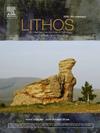南海北缘MORBs Mo-Sr-Nd-Hf同位素约束下大陆分裂后新生洋盆地幔演化
IF 2.9
2区 地球科学
Q2 GEOCHEMISTRY & GEOPHYSICS
引用次数: 0
摘要
大陆分裂和边缘海盆扩张初期地幔的地球化学特征尚不清楚。国际海洋发现计划(IODP) 367和368X科考队在南海北缘U1500B和U1503A孔采集的洋中脊玄武岩(MORB)样品,为研究大陆分裂后新生洋盆的地幔演化提供了重要线索。U1500B孔的MORB样品更靠近陆-海过渡带,87Sr/86Sr比值较高,εNd和εHf值较低。它们的δ98/95Mo值与Mo/Ce和Mo/Nb比值呈正相关,表明地幔源区受大洋再循环地壳(ROC)影响。U1503A孔的MORB样品δ98/95Mo值范围较宽,87Sr/86Sr比值较高,而εNd和εHf值较U1500B孔低,这主要是由于陆源沉积物对次大陆岩石圈地幔(SCLM)的交代作用程度不同。N-SCS中两个地点的morb的微量元素和Mo-Sr-Nd-Hf同位素组成的差异突出了大陆分裂后新生海洋盆地地幔源的重大转变。在南海海底扩张的初始阶段,新生洋中脊下的地幔源可能被补充了丰富的成分,这些成分可能来自中生代以来的俯冲作用。这项研究为新生海洋盆地地幔演化提供了重要的地球化学见解。长时间的俯冲导致大量富集成分进入地幔,可能降低其固体温度,从而促进岩石圈快速破裂和广泛的岩浆活动在南海早期发展。本文章由计算机程序翻译,如有差异,请以英文原文为准。
Mantle evolution of the nascent oceanic basin subsequent to continental breakup constrained by Mo–Sr–Nd–Hf isotopes in MORBs from the northern margin of the South China Sea
The geochemical characteristics of the mantle during continental breakup and the initial spreading of marginal sea basins remain poorly understood. Mid-ocean ridge basalt (MORB) samples from Holes U1500B and U1503A in the northern margin of the South China Sea (N-SCS), obtained during International Ocean Discovery Program (IODP) Expeditions 367 and 368X, provide crucial insights into mantle evolution of the nascent oceanic basin subsequent to continental breakup. MORB samples from Hole U1500B, closer to the continent-ocean transition zone, exhibit higher 87Sr/86Sr ratios, along with lower εNd and εHf values compared to the depleted mantle. Additionally, their δ98/95Mo values correlate positively with Mo/Ce and Mo/Nb ratios, indicating the influence of recycled oceanic crust (ROC) in the mantle source. In contrast, MORB samples from Hole U1503A, nearer to the oldest fossil ridge of the steady-state ocean, show a broader range of δ98/95Mo values, higher 87Sr/86Sr ratios, and lower εNd and εHf values compared to those from Hole U1500B, due to varying extents of subcontinental lithospheric mantle (SCLM) metasomatized by terrigenous sediment input into the mantle source. The distinct trace element and Mo–Sr–Nd–Hf isotope compositions of MORBs from the two sites in the N-SCS highlight a significant transition in the mantle source of the nascent oceanic basin subsequent to continental breakup. During the initial stages of seafloor spreading in the SCS, the mantle source beneath nascent mid-ocean ridges may have been replenished with enriched components, likely derived from subduction-related processes since the Mesozoic. This study offers critical geochemical insights into the evolution of the mantle in nascent oceanic basins. The prolonged subduction led to substantial amounts of enriched components into the mantle, potentially lowering its solidus temperature, thereby facilitating rapid lithospheric rupture and extensive magmatism during the early development of the SCS.
求助全文
通过发布文献求助,成功后即可免费获取论文全文。
去求助
来源期刊

Lithos
地学-地球化学与地球物理
CiteScore
6.80
自引率
11.40%
发文量
286
审稿时长
3.5 months
期刊介绍:
Lithos publishes original research papers on the petrology, geochemistry and petrogenesis of igneous and metamorphic rocks. Papers on mineralogy/mineral physics related to petrology and petrogenetic problems are also welcomed.
 求助内容:
求助内容: 应助结果提醒方式:
应助结果提醒方式:


